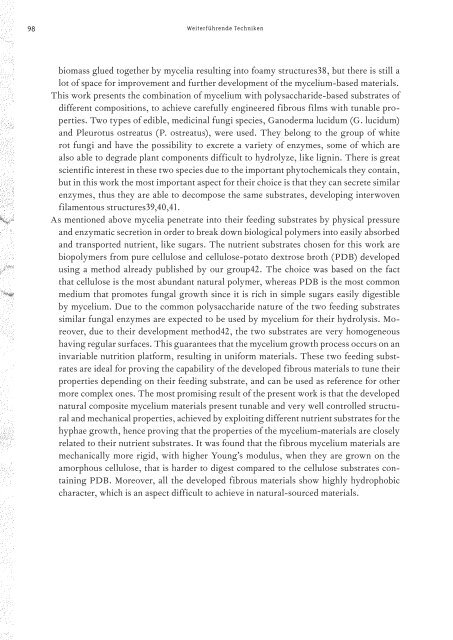Logbuch_17x24Druck_einzelseiten
You also want an ePaper? Increase the reach of your titles
YUMPU automatically turns print PDFs into web optimized ePapers that Google loves.
98<br />
Weiterführende Techniken<br />
biomass glued together by mycelia resulting into foamy structures38, but there is still a<br />
lot of space for improvement and further development of the mycelium-based materials.<br />
This work presents the combination of mycelium with polysaccharide-based substrates of<br />
different compositions, to achieve carefully engineered fibrous films with tunable properties.<br />
Two types of edible, medicinal fungi species, Ganoderma lucidum (G. lucidum)<br />
and Pleurotus ostreatus (P. ostreatus), were used. They belong to the group of white<br />
rot fungi and have the possibility to excrete a variety of enzymes, some of which are<br />
also able to degrade plant components difficult to hydrolyze, like lignin. There is great<br />
scientific interest in these two species due to the important phytochemicals they contain,<br />
but in this work the most important aspect for their choice is that they can secrete similar<br />
enzymes, thus they are able to decompose the same substrates, developing interwoven<br />
filamentous structures39,40,41.<br />
As mentioned above mycelia penetrate into their feeding substrates by physical pressure<br />
and enzymatic secretion in order to break down biological polymers into easily absorbed<br />
and transported nutrient, like sugars. The nutrient substrates chosen for this work are<br />
biopolymers from pure cellulose and cellulose-potato dextrose broth (PDB) developed<br />
using a method already published by our group42. The choice was based on the fact<br />
that cellulose is the most abundant natural polymer, whereas PDB is the most common<br />
medium that promotes fungal growth since it is rich in simple sugars easily digestible<br />
by mycelium. Due to the common polysaccharide nature of the two feeding substrates<br />
similar fungal enzymes are expected to be used by mycelium for their hydrolysis. Moreover,<br />
due to their development method42, the two substrates are very homogeneous<br />
having regular surfaces. This guarantees that the mycelium growth process occurs on an<br />
invariable nutrition platform, resulting in uniform materials. These two feeding substrates<br />
are ideal for proving the capability of the developed fibrous materials to tune their<br />
properties depending on their feeding substrate, and can be used as reference for other<br />
more complex ones. The most promising result of the present work is that the developed<br />
natural composite mycelium materials present tunable and very well controlled structural<br />
and mechanical properties, achieved by exploiting different nutrient substrates for the<br />
hyphae growth, hence proving that the properties of the mycelium-materials are closely<br />
related to their nutrient substrates. It was found that the fibrous mycelium materials are<br />
mechanically more rigid, with higher Young’s modulus, when they are grown on the<br />
amorphous cellulose, that is harder to digest compared to the cellulose substrates containing<br />
PDB. Moreover, all the developed fibrous materials show highly hydrophobic<br />
character, which is an aspect difficult to achieve in natural-sourced materials.


